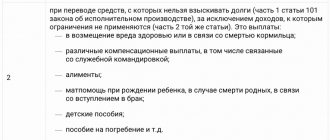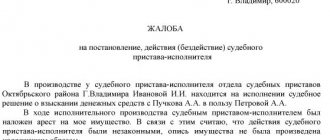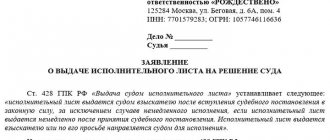Many organizations have employees whose salaries make regular deductions to pay off certain debts. For example, this may be related to the payment of alimony. The basis for such penalties are writs of execution and other similar documents.
A separate notification to the bailiffs is sent if the employee decides to terminate the employment contract. Let's talk about the rules for drawing up a document.
Dear readers! Our articles talk about typical ways to resolve legal issues, but each case is unique.
Notification of bailiffs about the debtor's dismissal
There is a law that specifically deals with issues of enforcement proceedings. However, there is no specific time frame within which notice must be given. It is written only that employers are obliged to carry out such actions as quickly as possible after the incident.
An exception is made only in the case of alimony. A specific period of three days is set here. And nothing is reported about the time of return of the writs of execution. The best solution is when such documents are sent to the addressee literally the next business day after the incident.
Any violations of the deadlines may result in fines:
- within 50-100 thousand rubles when working with organizations;
- 15-20 thousand rubles for officials.
If, after dismissal, a citizen leaves the family, he often remains obligated to pay alimony. The law regulates the specific amount of possible amounts. Usually this is a fixed sum of money, or a certain percentage of earnings. The writ of execution is sent to the place of work.
When the alimony worker is fired, the citizen himself must inform the bailiffs about what happened. In this case, an official letter is sent to the bailiffs about the dismissal of the debtor on behalf of the management of the enterprise where the work was previously carried out.
When employed in a new place, the executive documentation must again be transferred to accountants.
Dismissal procedure
Regardless of what was the reason for terminating the employment relationship between the employee and the employer - failure to fulfill labor obligations or the personal desire of the person to leave his position - the procedure for dismissing the alimony payer must be followed. For example, when removing a person from a position for absenteeism, the procedure will be as follows:
- identification of the fact of absenteeism and documentary evidence (memo, act, etc.);
- determining the reason for absenteeism - the presence or absence of valid reasons;
- registration of dismissal under the relevant article with making a note in the work book and personal file.
Because the presence of minor children who are entitled to monthly payments is not a “mitigating circumstance,” an employee can be dismissed according to the same scheme and on the same grounds as other employees. The only nuance can be considered an increase in bureaucratic procedures and mandatory compliance with the following formalities:
- drawing up and sending notices and writs of execution to bailiffs;
- sending a corresponding notice to the second parent receiving child support.
The employer is responsible for the timely provision of the specified documentation to the authorities.
How to write a cover letter?
Typically, such letters are compiled and sent to the recipients after the main actions have been completed.
Any sample letter to bailiffs stating that the debtor is not working must contain the following information:
- indication of a specific residential address;
- data on the new place of work, if available;
- list of application documents;
- the balance of the debt along with the reasons for its occurrence;
- the period during which the funds were transferred previously;
- order details;
- a description of the fact of dismissal with reference to the relevant document.
The chief accountant and the manager must sign the application; it is impossible to do without using a company seal.
In the envelope with the letter they put:
- a copy of the dismissal order;
- writ of execution, where the exact amounts are indicated.
Making copies is a mandatory action for any documents issued in person. They are stored in the enterprise archive for a long time. The same applies to papers that the Federal Bailiff Service has already received.
The debtor must have in his hands:
- employment history;
- order in the form of a copy.
Copies should be kept in case government authorities conduct additional inspections. Then the simplest answer to the bailiff, stating that the debtor does not work for the organization, will come in handy.
You can view a sample letter to bailiffs regarding the dismissal of a debtor on our website by following the link.
Letter to representatives of the FSSP stating that the debtor resigned
In accordance with sub. 2 clause 4.1 in case of dismissal of the debtor, the employer is obliged to send to the bailiff:
- a copy of the writ of execution with a note indicating the reason for the end of execution of the document;
- and the amount that was withheld for the entire time the employee worked in a particular organization.
Thus, the covering letter to the bailiffs is an official document that is sent to the FSSP after the termination of the employment contract with the debtor, complete with a writ of execution. An order for the dismissal of a specific employee must also be attached here.
It should be borne in mind that sending such a document is a mandatory requirement.
In case of failure to comply with the notification procedure, the employer may be fined:
- for citizens - from 2,000 to 2,500 rubles;
- for officials - director, head of the personnel department - from 15,000 to 20,000 rubles;
- for legal entities - from 50,000 to 100,000 rubles.
Such amounts are specified in Part 3 of Art. 17.14 Code of Administrative Offenses of the Russian Federation.
When is it compiled?
A covering letter to bailiffs is drawn up upon the dismissal of an employee from whose wages deductions were made on the basis of a writ of execution. It could be:
- payment of alimony;
- repayment of debt to the bank;
- compensation for damage caused to another person;
- fines;
- other types of deductions.
In this case, the main reason for sending a covering letter, including the papers attached to it, is the termination of the execution of the writ of execution. It is also worth emphasizing that the bailiffs must be notified of this event not only when the debtor is dismissed, but also in a number of other situations (for example, when transferring money in full, in connection with the filing of an application by the debtor, etc.).
How to write correctly?
The current legislation does not have any requirements or rules for writing a cover letter to bailiffs. There is also no single example of such a document.
It is drawn up in any form on A4 paper. It can be prepared on the letterhead of an organization acting as an employer.
The standard structure of a cover letter for the dismissal of a debtor is represented by the following points:
- “Head” of the document - here the details of the employing company (name, location) and information about the addressee are indicated, that is, the full name of the territorial branch of the FSSP and its address.
- Registration data - the number and date of registration of the letter in the company’s outgoing correspondence.
- Title of the document - the following wording can be used here: “Notice of dismissal of the alimony payer.”
- Content part — this section should consistently contain the following information:
- Full name of the debtor;
- the position he held in the organization;
- details of the writ of execution on the basis of which deductions from wages were made (number and date, name of the judicial authority);
- reason for dismissal;
- the day until which the deductions were made, and a note indicating the absence of uncollected debt;
- message about the return of the writ of execution.
- At the end of the document there must be signatures (of the manager and chief accountant), as well as the seal of the organization.
How to report a fired employee?
Based on the provisions of clause 4.1 of the law mentioned above, the writ of execution must be sent to the bailiffs the next day after dismissal .
However, in individual cases this period may change. For example, if an employee is a payer of alimony, then the administration of the organization in which he works must notify the bailiff within 3 days of the fact of the payer’s dismissal (clause 1 of Article 111 of the RF IC). In this case, it is also necessary to inform about the new place of work of the person liable for alimony (if it is known to the former employer).
In general, a covering letter with attachments can be sent to the bailiffs in one of the following ways:
- delivered via courier;
- sent by mail (by a valuable letter with acknowledgment of delivery).
Return of the resolution to the bailiffs upon dismissal of the debtor
Decrees are documents that are issued to an enterprise to enforce a court decision when the need arises. Article 428 of the Civil Code of the Russian Federation regulates the procedure for issuing such documents.
The main thing is that the total period for carrying out enforcement actions does not exceed two months . Only the judicial act itself can indicate other conditions and rules regarding deadlines.
Documents for execution are submitted directly by the creditor. The FSSP service may also be responsible for this. Accounting must register writs of execution, classifying them as standard incoming documentation. Or a special accounting journal is used for them.
A special mark is placed on the cut-off coupon when the document is received from the bailiffs. After that everything is sent back. The manager must inform the employee himself that deductions will be made from the salary.
The reasons for termination of collections may be as follows:
- the foreign defendant was expelled from the Russian Federation by court decision;
- the creditor creates obstacles to the execution of the decision;
- the claims were satisfied in full;
- there are no sources for debt repayment;
- the debtor is hiding, which is why the location is no longer known;
- enforcement actions in relation to the debtor cannot be carried out;
- The plaintiff himself drew up a written appeal on this matter.
Shipping deadlines and liability for violating them
When the decision is returned to the bailiff, the debtor is dismissed. The action is performed by the chief accountant. It is carried out immediately after the corresponding basis appears.
The main requirement is the availability of detailed information regarding amounts, as well as payment deadlines. Performers may additionally request copies of payment documents to confirm any information.
The bailiff must be called and informed of the situation if immediate dispatch is not possible due to the financial situation in which the company finds itself. The collection procedure can be restored when the need arises.
Administrative liability is the minimum punishment for those who violate the return deadline, although there is no valid reason.
Documentation for returning writs of execution
If there are grounds for terminating the collection procedure from the debtor, then you need to collect a whole set of documents, which cannot be avoided. They are sent through postal services, the main addressee being the relevant government service. Its employees are always ready to explain how to answer the bailiffs that the debtor does not work for the organization.
Departure is carried out for:
An application from the employer is drawn up using a free form. There is no regulated form, therefore the option of using letterhead is allowed. The appeal includes all contact information that, if necessary, will help contact interested participants in the process.
The employer can report a new job if it is known for sure. Such information is also included in the covering letter to the bailiffs upon dismissal of the debtor.
What to do if a decree has been issued regarding penalties against a dismissed employee?
If the order to collect alimony comes to a long-dismissed employee, the document should be returned to the bailiff with a covering letter.
The fact of return is recorded in writing in the registration and accounting journal. Documentary evidence of the return is also kept documented (for example, a list of the contents when sending papers by registered mail). The procedure for terminating working relationships with persons who pay alimony differs significantly from the standard procedure.
It is for this reason that the employer must familiarize himself with all the nuances and rules of this process. The main thing in such a case is to ensure that the person in charge has completed all the necessary actions. Otherwise, the likelihood of fines being assessed increases significantly. If difficulties and questions arise in practice, it is advisable to involve an experienced lawyer.
Dear readers, the information in the article may be out of date, take advantage of a free consultation by calling: Moscow +7
, St. Petersburg
+7 (812) 425-62-38
, Regions
8800-350-97-52
An example of a letter to a bailiff about termination of an employment contract with a debtor
By virtue of paragraph 1 of Art. 98 of the Law “On Enforcement Proceedings” dated October 2, 2007 No. 229-FZ (hereinafter referred to as the Law on Enforcement Proceedings), a penalty can be applied to the salary:
- if there are debts on periodic payments;
- collection of a sum of money in the amount of less than 10,000 rubles;
- the debtor lacks other funds and property to pay off the debt.
The grounds for collection may be alimony payments, compensation for harm caused, arrears of taxes, fees, etc.
After receiving a writ of execution (hereinafter referred to as IL), the deduction from the debtor’s salary is carried out by the employer or another person who makes periodic payments to the debtor. For details, see our article “Deduction from wages under a writ of execution.”
The above persons must inform the bailiff about the termination of the employment contract with the debtor employee and return the IL no later than the next day (clauses 4, 4.1 of Article 98 of the Law on Enforcement Proceedings). The specified letter is drawn up in any form. An example of a document can be viewed at the link: Sample letter to bailiffs about the dismissal of a debtor.
Withholding under executive documents: general provisions
An executive document received by the organization in the name of an employee is the basis for collecting from the employee’s salary the amounts specified in the document.
An executive document can be: (click to expand)
- performance list;
- certificate issued by the labor dispute commission;
- act of regulatory authorities on the collection of credit debt and accrued interest;
- a judicial act issued in accordance with the Code of Administrative Offences;
- order of bailiffs;
- a notary's writ of execution on an agreement on out-of-court dispute resolution.
In accordance with the provisions of Federal Law 223, the employer is obliged to make deductions from the moment of receipt of the writ of execution.
In order to make penalties, the employee's consent is not required. The employer only needs to notify the employee in writing (the employee’s signature “Notified” on the writ of execution), after which the accountant has the right to withhold the amounts in the manner established by the writ of execution.
What to send to bailiffs when terminating an employment contract with an alimony provider
The procedure for collecting alimony payments is regulated not only by Art. 98 of the law on enforcement proceedings, but also Ch. 17 of the Family Code of the Russian Federation (hereinafter referred to as the Code). By virtue of Art. 109 of the Code, the employer must withhold funds on the basis of:
- alimony payment agreement certified by a notary;
- IL.
Read about the rules for calculating alimony in our article “Calculation of alimony from wages.”
Clause 1 Art. 111 of the Code establishes the employer’s obligation to inform the bailiff and the person receiving alimony payments about the termination of the employment contract with the alimony-paying employee. The question often arises about what else to send to the bailiffs when dismissing the alimony worker?
The answer to this question is contained in clause 4.1 of Art. 98 of the law on enforcement proceedings. No later than the next day after the dismissal of the alimony employee, the IL must be returned to the bailiff indicating the amount collected.
The notarial agreement submitted by the recipient of the alimony must be returned to this person with a note about the period the agreement was in this organization and the amount of money paid.
Dispatch procedure and timing
To send a document, you need to know the deadlines and procedures. The deadlines are different and it depends on who the citizen owes and for what. If there is a debt to a banking organization, the resolution should be sent as soon as possible after the dismissal has occurred, but specific deadlines have not been established. If a company employee makes deductions for alimony, you should be guided by the Family Code of the Russian Federation, which sets a period of 3 working days.
Meeting deadlines is not a mere formality. The bailiff must receive notice of the employee's dismissal. Otherwise you will face a fine. For an individual this is an amount of 2,500 rubles, and for companies from 50 to 100 thousand rubles.
An example of a letter to a bailiff about termination of an employment contract with an alimony worker
The notice of dismissal of the alimony provider is drawn up in any form, like the letter of dismissal of any debtor. The document is drawn up on the employer’s letterhead and contains:
- date of compilation;
- outgoing number (if available);
- Full name of the alimony provider;
- link to paragraph 1 of Art. 111 of the Code, paragraph 4.1 of Art. 98 of the law on enforcement proceedings;
- date and grounds for termination of the employment contract;
- the date on which salary deductions were made;
- debt and the reasons for its occurrence (if any);
- new place of work of the alimony worker (if known).
The document is signed by the head of the alimony payer’s former employer.
The attachment to the message is an IL with a mark that contains the following data:
- about the withheld amounts of funds;
- numbers of payment documents with which the funds were transferred to the alimony recipient;
- dates of transfer of alimony payments;
- balance of debt.
This mark is certified by the seal of the enterprise (if any) and the signature of an authorized person (see paragraph 10 of section II of the Memo for managers and accountants of the organization..., which is Appendix 1 to the Methodological Recommendations, approved by the Federal Bailiff Service on June 19, 2012).
By virtue of paragraph 1 of Art. 111 of the Code, the recipient of payments must also be notified of the dismissal of the alimony provider. It is allowed to issue one document sent to 2 addresses. An example of filling can be viewed at the link: Sample letter to bailiffs about the dismissal of an alimony worker.
A sample letter to a bailiff regarding the dismissal of a debtor can be downloaded from the link provided in this article. It is necessary to attach a writ of execution to the document with a note about the withheld funds and send everything to the bailiff the next day after termination of the employment contract with the debtor. If the debtor is the payer of alimony, then the notice must also be sent to the recipient of the alimony. If the writ of execution was a notarized agreement on the payment of alimony, then this agreement is sent to the address of the recipient of alimony payments.
Was the article useful? Subscribe to our channel RUSYURIST in Yandex.Zen!
Nuances
The dismissal of an alimony payer does not mean the termination of payments. After delivering a letter of termination of the employment contract to the second parent, he has the right to control the situation by inquiring about the receipt of information about the new place of work from the bailiffs.
A notification letter must be sent to the parent on the day of termination. Timely information is clearly regulated by law. A delay of even one day may be grounds for filing a complaint.
Sources
- https://gidbankrot.ru/dolzhniki/pismo-sudebnym-pristavam-dolzhnik-ne-rabotaet
- https://bankrotof.net/ispolnitelnoe-proizvodstvo/pismo-sudebnym-pristavam-o-pogashenii-dolga/
- https://online-buhuchet.ru/vozvrat-ispolnitelnogo-lista-sudebnym-pristavam/
- https://rabotnik-info.ru/uvolnenie/alimentshhika/
- https://otrude.com/uvolnenie/vernut-ispolnitelnyy-list-pristavam/
[collapse]
Letter to bailiffs
Letter to bailiffs
DEPARTMENT OF ROAD BRIDGES AND ENGINEERING CONSTRUCTION OF THE CITY OF MOSCOW
STATE UNITARY ENTERPRISE OF THE CITY OF MOSCOW
"M"
Address: Phone:
No.______ dated “____”_____ 20____
Lefortovo Department of Bailiffs
Office of the Federal Bailiff Service of Russia in Moscow
109377, Moscow, st. Zelenodolskaya, 8/13
To the bailiff
Khankishiev Z.A.
We hereby inform you that Pavel Valerievich Yudin was hired under a fixed-term employment contract No. 20 dated 09/03/2009 for the position of mechanic mechanic from September 03, 2009 (employment order No. 116/2 hp dated 09/02/2009 G.).
On 10/30/2009, the fixed-term employment contract was terminated at the initiative of the employee (at his own request) (dismissal order No. 143 hp dated 10/27/2009)
Currently, Pavel Valerievich Yudin has neither labor nor civil law relations with the State Unitary Enterprise of Moscow “M”; all payments due to them have been received in full.
Thus, make deductions from the wages of P.V. Yudin. not possible.
Employment order No. 116/2 hp. from 02.09.2009
Order of dismissal No. 143 hp. dated October 27, 2009
Head of State Unitary Enterprise of Moscow
Components of a letter
The document must contain an introductory, main and final part. The introduction must contain the following information:
- Details of the organization from whose staff the alimony payer was excluded: address, telephone numbers, zip code, etc.
- Direct indication (appeal) to a specific department of bailiffs. It is not necessary to indicate the name of a specific bailiff (it is usually unknown). There is enough separation here, indicating the place of attachment. This will be enough to correctly compose the letter to the bailiffs.
- Appeal to the alimony collector. You should send a letter not only to the bailiffs, but also to the specific recipient of alimony. And in this case, the data of the full name, surname, patronymic, as well as the address with an index must be provided. Without indicating the recipient of alimony, the letter completely loses its meaning and legal force.
- Date the document was signed.
- His number. It is he who is indicated in the registration documentation. In turn, these records will serve as evidence that the correspondence was sent.
- Name of paper.
The main part, as is customary in business correspondence, should be specific, complete and reasoned. The introduction of the main body of the letter should contain the following information:
- For what reason is the letter being sent? Everything is clear here - dismissal.
- A link to a document obliging the employee to pay alimony. In the given sample letter to the bailiffs when dismissing an alimony worker, this basis is paragraph 1 of Article 111 of the RF IC. It is this that is referred to in the vast majority of cases in letters of alimony payment.
- Link to outgoing letter from bailiffs. She will explain the essence of the issue, the reason that prompted the organization to begin writing this letter. Dismissal is also a reason in itself. But if a request was sent from the bailiff service, then you need to refer to it, indicating the date and number of the corresponding letter.
After the preamble (immediately after the phrase “we inform the following”), there is the text of the message itself, including:
- Full name of the dismissed employee.
- The position, specialty for which he was previously hired.
- On the basis of which the employee pays alimony. The number and date of the writ of execution on the basis of which he is obliged to do this are indicated.
- Which judicial district issued the writ of execution (it would be logical if the letter was sent exactly to the district in which the paper on the collection of alimony was issued).
- When the dismissal occurred (date).
- For what reason did the employee quit? If this is a voluntary dismissal, then there must be a reference to clause 3, clause 1, part 77 of article 77 of the Labor Code. If for other reasons, then the references to legislation will be different, but their presence is highly encouraged by regulatory authorities when conducting inspections. This makes the process more convenient.
- Has the final payment been made? If not made and there are debts, then be sure to indicate the reason for their occurrence.
- Final settlement date (if any).
- The name of the address of the former employee's new place of work. Even if before his dismissal he did not inform where he was transferring or not transferring. In any case, the phrase about the place of work must be present, recording the good faith of the employer, his willingness to provide any assistance to the bailiff service and other authorities involved in the collection of alimony.
- Place of residence of the alimony provider, which was recorded in the organization’s papers. It is indicated as the last place of residence.
- Information that the writ of execution is sent to the bailiff for further collection of alimony.
The text of the main part ends with this phrase. The conclusion is quite succinct. If a former employer wants to formalize a letter to the bailiffs in a legally competent manner, then it will be enough to sign the accountant and manager and the seal of the organization at the end, as well as provide links to the attached documents. The latter are a writ of execution and a copy of the order to dismiss the employee (this is the minimum set of attached papers).
In what cases is it compiled?
Often, to enforce a court decision, a measure such as collecting interest from wages is used. This measure is one of the most common and effective only in cases of official employment of the debtor.
Sometimes situations arise when a debtor employee quits on his own initiative or on the initiative of the employer. In this case, FSSP officials must be notified that the employee has been fired. It is necessary to notify the debtor of his dismissal by sending a letter to the bailiff service. A notification letter must be sent in any case when an organization is given a writ of execution to pay off wage arrears. It does not matter what type of debt the debtor has. This could be either alimony or unpaid fines or housing and communal services debts.
What happens to the document if an employee is fired?
A writ of execution is one of the types of enforcement documents; it is issued on the basis of a decision, ruling or court order. It contains data from the operative part:
- name of the judicial authority;
- case number;
- dates of the decision, issuance of the sheet, entry into force;
- the demands presented to the defendant (in this case, he is the employee);
- an excerpt from the decision (the text must strictly coincide with the court’s conclusions about the satisfaction of the claim in full or in part, and contain information about the procedure and amounts to be recovered);
- details of the parties to the case (full name, date and place of birth, registration address - details of an individual, full name of the organization, TIN, date of registration - details of a legal entity);
- document number and series.
A writ of execution is issued only by the court on the basis of an application for the issuance of this document. It can be sent to the bailiff department or handed over to the claimant, his representative by proxy, so that he can present it to the debtor’s employer for execution.
It is also necessary to provide an application containing the data of the claimant and, necessarily, bank details for transferring deductions.
Once the employer has received a writ of execution, you need to:
- notify the bailiff of receipt of the document (if notification was sent);
- register the writ of execution in a special journal for registration of such documents;
- ensure its safety.
upon dismissal of an employee, the employer is obliged to return the writ of execution with notes on what basis the execution was terminated, during what period it was carried out, and what amounts were collected.
This must be done no later than the working day following the day of dismissal. Within the same period, it is necessary to notify the bailiffs and the collector about the dismissal of the debtor, indicating the amount of deductions made.
How to write a letter to bailiffs about the dismissal of an employee
The bailiff's letter regarding the dismissal of the debtor must be sent in writing. It must include the following elements:
- Company name and details.
- The name of the FSSP department to which the letter is sent (the employee’s full name may not be indicated. The letter will be distributed to the responsible bailiff).
- Letter title.
- The text of the letter, which contains a notification of the fact of dismissal of an employee, indicating the full name of the employee, details of the writ of execution that was transferred to the company.
- Date of writing the letter, signature of the chief accountant and manager, seal of the organization.
The original writ of execution and a copy of the dismissal order are sent as an attachment to the letter. Among other things, the employer is obliged to notify the FSSP of the amount of penalties imposed.
What should an accountant do?
After the dismissal of the alimony worker, the accountant needs to do important work - collect a personal file and send it to the company’s archives. The following documents should be placed in your personal file:
- a copy of the writ of execution, which contains information about funds withheld from wages and the balance of payments;
- a duplicate of the dismissal order;
- copies of notification letters sent to the executive authorities and to the second parent;
- a list of papers that make up a personal file.
If the company has a documentation log, then a corresponding note is made in it, the date of dismissal and sending of documents is indicated.
Retention after a person has left the organization
After an employee quits, deductions from his salary by this organization cease.
Exceptional cases are established by the Labor Code of the Russian Federation, Part 2 of Art. 137. An employer can withhold money from wages upon dismissal if:
- the employee was given an advance, but he did not pay it off;
- the employee was overpaid due to accounting errors;
- the employee was found to be guilty of failure to comply with labor standards (Part 3 of Article 155 of the Labor Code of the Russian Federation) or downtime (Part 3 of Article 157 of the Labor Code of the Russian Federation);
- the employee was granted leave in advance - for the actual vacation days not worked.
There will be no deductions for days of vacation not taken if the employee quits for the following reasons:
- refusal to transfer to another job;
- liquidation of the organization;
- staff reductions;
- conscription for military service;
- reinstatement at work;
- inability to work for medical reasons;
- occurrence of an emergency.
Where should the execution paper be returned?
When an employee quits, the employer is obliged to:
- notify the bailiffs that collection of amounts under the writ of execution is impossible;
- return the sheet to the bailiff department.
The writ of execution must be returned along with the application and a copy of the dismissal order. The application shall indicate:
- the amount of penalties made;
- the reason why further penalties are impossible (in this case, it is the dismissal of the employee);
- information about the debtor’s new place of work, if such information is available.
Can they be expelled from the state in connection with the execution of a court decision?
It is impossible to dismiss an employee because a writ of execution has been issued against him. The grounds on which an employee can be dismissed are enshrined in the Labor Code of the Russian Federation and their list is exhaustive. Since the law does not provide for such a basis, dismissal in this case will be unlawful, since the reasons due to which a person became a debtor may be serious and valid.
Upon receipt of a writ of execution, the employer only has the obligation to collect the established amounts from wages, but not in any way to deprive an employee in a difficult life situation of the main source of income.
The fact of illegal dismissal can be appealed by the employee in court.











